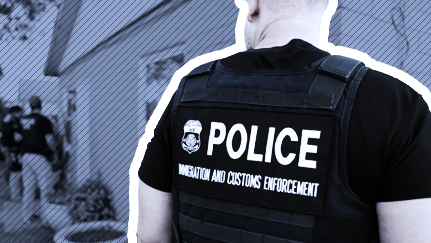Enforcement of U.S. immigration laws has historically been guided by policies that emphasize prioritization. However, this practice has largely been abandoned since the inauguration of President Donald Trump.
This fact sheet explains the shift in enforcement philosophy under the Trump administration and outlines the effects of this change. The get-tough approach to enforcement—portrayed by the administration as an attempt to “restore the rule of law”—in effect diverts the attention of law-enforcement agencies from those who have committed serious crimes and those who are serious public threats.
Enforcement Without Priorities
Whereas prior policies outlined a framework for prioritizing U.S. resources—such as emphasizing the removal of persons convicted of serious crimes—the Trump administration expanded “enforcement priorities” so broadly as to render the term meaningless. As U.S. Immigration and Customs Enforcement (ICE) stated in a year-end report, ICE no longer exempts groups of removable [noncitizens] from enforcement. In other words, all undocumented immigrants have become targets—even if they have lived in the United States for many years, have U.S.-born children, and have never had a run-in with law enforcement.
The Trump administration laid out its enforcement priorities in the executive order, “Enhancing Public Safety in the Interior of the United States,” signed on January 25, 2017. The order defines as a priority any non-U.S. citizen who:
- has been convicted of any criminal offense;
- has been charged with any criminal offense, where the charge has not been resolved;
- has committed acts that constitute a chargeable criminal offense;
- has engaged in fraud or willful misrepresentation in connection with any official matter or application before a government agency;
- has abused any program related to the receipt of public benefits;
- is subject to a final order of removal, but has not departed; or
- otherwise poses, in the judgment of an immigration officer, a risk to public safety or national security.
The subsequent Department of Homeland Security (DHS) memorandum implementing this executive order severely curtailed the ability of immigration-enforcement personnel to assess an individual’s equities when making case decisions. In the words of the memo: “prosecutorial discretion shall not be exercised in a manner that exempts or excludes a specified class or category of [noncitizens] from enforcement of the immigration laws.” Put differently, all DHS personnel “shall faithfully execute the immigration laws of the United States against all removable [individuals].”
A Look at the Numbers
This shift in enforcement philosophy has translated to more arrests and deportations of noncitizens. The increase is apparent in ICE statistics. Between January 25, 2017, and the end of fiscal year (FY) 2017 (September 30, 2017), ICE made 110,568 arrests—a 42 percent increase over the 77,806 arrests made during the same period in 2016.
More detailed ICE statistics require a closer look. Specifically, ICE grouped together those convicted of crimes and those only charged with crimes when totaling arrests made between January 25 and September 30, 2017. As a result, ICE reported that 92 percent of arrests during that period were of individuals who either had criminal convictions or criminal charges pending final disposition.
In addition to the problematic accounting that results from combining convictions and charges, the term “criminal” is defined very broadly. For instance, the largest numbers of convictions or charges pending were for non-violent crimes—traffic offenses, immigration offenses (such as unlawful entry or reentry into the country), and drug offenses (including possession). In addition, roughly 1 in 10 individuals arrested during FY 2017 had neither criminal convictions nor criminal charges pending.
Exercising Discretion: 1996 to 2017
One of the crucial mechanisms in the enforcement of U.S. immigration law and criminal law is the exercise of discretion—and not just prosecutorial discretion. At the broadest level, discretion refers to the decision by a law-enforcement officer, prosecutor, or some other government official to pursue (or not pursue) the enforcement of certain laws against a person, or group of people, who may have violated those laws.
Discretion comes into play at every juncture of the law-enforcement process. In the criminal justice system, police decide whether to arrest someone; prosecutors decide if they should bring charges against that person; and judges decide what punishment to hand down to an individual who has been convicted.
Discretion is critical to ensuring the criminal justice system functions properly. This is due in large part to the limited availability of resources. There simply aren’t enough police, prosecutors, and other criminal-justice personnel to act against every person who may have violated any one of the hundreds of thousands of laws on the books, no matter how minor. Given this limitation, the most rational use of law-enforcement resources is to prioritize more serious offenses over relatively minor ones. Other factors also enter into the equation when deciding whether to exercise discretion, such as how strong the evidence is against the accused, whether the accused has a prior criminal history, and how cooperative the accused is in assisting authorities with other investigations or prosecutions.
For the most part, the discretionary considerations applicable in criminal law also apply in immigration law. Although immigration laws are civil in nature, the stakes remain high since penalties for violations can be extremely harsh—including long-term or lifetime banishment from the United States. Federal prosecutors commonly threaten criminal charges to get an immigrant to agree to voluntarily depart and avoid being placed in deportation proceedings. In fact, deportation often occurs even if criminal charges are dropped.
How 1996 Legislation Changed Discretion
Immigrants are almost certain to be prosecuted after arrest in large part because U.S. immigration law has taken much of the discretionary power away from prosecutors and judges. Under the Illegal Immigration Reform and Immigrant Responsibility Act (IIRIRA) and the Antiterrorism and Effective Death Penalty Act (AEDPA), both passed in 1996, immigrants—even lawful permanent residents (LPRs)—may be subject to mandatory detention and deportation for an offense which Congress defines as an “aggravated felony” for immigration purposes. An “aggravated felony” can encompass offenses ranging from shoplifting to murder and, for non-citizens, is applied retroactively even in cases where the offense in question was committed long before it was added to the list of aggravated felonies.
Discretion under the Obama Administration
The Obama administration did exercise some measure of discretion in its approach to immigration enforcement. This was apparent in what became known as the “Morton memo”—a June 30, 2010, memo from then-ICE Director John Morton. The purpose of the guidance was to establish priorities that immigration officers should follow in deciding who to apprehend, detain, and deport. To this end, the memo defined three priority levels:
- threats to national security or public safety, including most migrants with criminal convictions of any kind;
- undocumented migrants who recently crossed the border; and
- migrants who didn’t heed a previous order of removal, or who re-entered the country after being deported.
While the Morton memo did represent an effort to create a rational set of enforcement priorities, it missed the mark. The single biggest problem with the hierarchy of priorities was that it lumped together offenses which are very different in nature. For instance, someone could be in Priority 1 for being a terrorist or for having committed an “aggravated felony” like shoplifting, which is neither a felony nor aggravated under criminal law as it is applied to U.S. citizens. Likewise, Priority 2 and 3 offenders likely included individuals who, for a variety of reasons, didn’t even realize that they had violated immigration laws. Even though the Morton memo offered little explicit guidance on prosecutorial discretion per se, it did single out lawful permanent residents (LPRs), juveniles, and the immediate family of U.S. citizens for special consideration.
A subsequent pair of memoranda from then-Director Morton, both dated June 17, 2011, offered more specific guidance on the exercise of discretion. The primary memo on the use of prosecutorial discretion outlined the government’s explicit immigration enforcement priorities; it further stated that any potentially deportable immigrant encountered by immigration authorities should be assessed on the basis of length of time in the United States, presence in the country since a very young age, education, military service, social ties to the United States, and age. In addition, this memo emphasized that “particular care” be taken with cases involving veterans, long-time LPRs, children and elderly individuals, victims of domestic violence or trafficking, and people with serious health conditions.
A November 2014 memo from then-DHS Secretary Jeh Johnson rescinded the Morton memos, articulating enforcement priorities applicable to the entire department rather than ICE alone. This detailed guidance similarly identified three civil immigration enforcement priorities:
- threats to national security, border security (specifically those apprehended while attempting to unlawfully enter the United States), and public safety;
- misdemeanants and new immigration violators (including anyone apprehended after unlawfully entering the United States and who had not been present in the United States since January 1, 2014); and
- “other immigration” violators, namely those who had been issued a final order of removal on or after January 1, 2014.
The Johnson memo also spelled out the many junctures at which discretion could be exercised in the immigration-enforcement process. According to the memo, prosecutorial discretion in the immigration context:
“should apply not only to the decision to issue, serve, file, or cancel a Notice to Appear, but also to a broad range of other discretionary enforcement decisions, including deciding: whom to stop, question, and arrest; whom to detain or release; whether to settle, dismiss, appeal, or join in a motion on a case; and whether to grant deferred action, parole, or a stay of removal instead of pursuing removal in a case.”
This guidance was rescinded in February 2017 by then-DHS Secretary John Kelly. The Kelly memo, “Enforcement of the Immigration Laws to Serve the National Interest,” greatly limited the exercise of discretion by immigration officials under the Trump administration.
The Human Cost
This shift away from enforcement priorities and into blind enforcement is socially destructive. At the most pragmatic level, it wastes finite law-enforcement resources on the apprehension and removal of people who represent no danger to public safety. More than that, immigration enforcement without priorities needlessly tears apart U.S. society itself. U.S. families, communities, and workplaces include immigrants and native-born citizens alike.
Undocumented immigrants—and legal immigrants who committed relatively minor crimes—cannot be neatly skimmed from the surface of society and expelled from the country. Many are parents, often to U.S.-born children who attend U.S. schools. In fact, of the 5.1 million children who have at least one undocumented parent, 4.1 million are native-born citizens. To attempt to remove all 11 million undocumented immigrants from our country’s social fabric, without prioritizing those who pose a danger, needlessly harms millions of other people who remain behind, regardless of where they were born.




